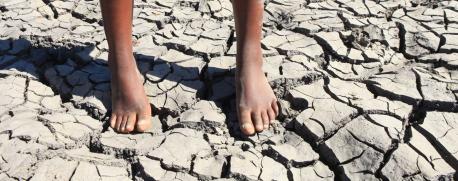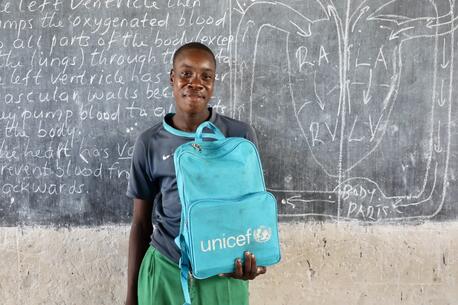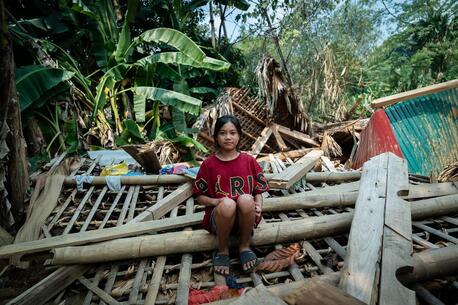
Climate Change
The climate crisis is a global emergency fueling humanitarian needs across the board. UNICEF's response centers around the need to protect, prepare and prioritize children to secure a safe and sustainable future. Learn how UNICEF is addressing the global climate emergency through cross-cutting programs.
The climate crisis is a child rights crisis
Children have the intrinsic right to a safe and clean environment. Yet nearly half the world's young population — nearly 1 billion children — live in countries where risks to their health and safety due to the effects of climate change are extremely high, countries where children are exposed to serious environmental hazards, shocks and stresses.
Children are not little adults; their bodies and minds are uniquely vulnerable to pollution, deadly diseases and extreme weather. Children are more likely than adults to suffer the effects of air pollution, for example, because they breathe faster, taking in more toxic air. Because infants and young children are less able to regulate their body temperatures and can more easily become dehydrated, they face higher risks to their health and well-being during a heat wave.
Children are growing up in a world made far more dangerous as a result of climate change and environmental degradation
Droughts, floods, wildfires, hurricanes and other extreme weather events related to climate change and global warming are multiplying in frequency and ferocity, endangering communities, creating food insecurity, threatening water supplies and forcing children to migrate — with their families or on their own. In the Caribbean alone, the number of children displaced by extreme weather events increased six-fold in just five years.
Consider:
- nearly 160 million children live in areas vulnerable to severe drought, and over 500 million children live in extreme flood zones — breeding grounds for deadly waterborne diseases
- almost half a billion children live in areas experiencing at least double the number of extremely hot days as their grandparents — many without the infrastructure or services to endure it; by 2050, it is expected that nearly all the world’s children — some 2 billion — will be exposed to heat waves, increasing certain health risks, especially for the very young
- it is estimated that by 2040, another 25 million children will suffer from malnutrition because of climate change
As temperatures rise and seasons become more unpredictable, children are increasingly aware that, while they are least responsible for the unfolding environmental crisis, they are the ones who are most threatened by its impact.
'This is what the climate crisis looks like' — a look at UNICEF's response to Horn of Africa drought emergency:
Responding to climate disasters by building community resilience to future shocks
When a weather disaster strikes, UNICEF focuses on delivering immediate relief to affected children and families. Emergency response is at the core of UNICEF's mission.
While helping to repair damaged infrastructure and otherwise support recovery, UNICEF also looks at ways to reduce disaster risks, helping communities rebuild in ways that ensure essential systems and services children rely on — water, health, nutrition, education — can better withstand future shocks. UNICEF also works closely with governments to help develop and implement disaster preparedness and risk reduction plans.
And UNICEF also works with partners to advance innovations that support climate adaptation, such as solar-powered water pumps and the use of satellite imagery to map new sources of ground water.
Another major component of UNICEF's climate work focuses on amplifying youth voices and advocating for more direct youth involvement in climate solutions — while also helping young people identify, develop and spearhead solutions in their communities.
From eco-anxiety to eco-optimism: supporting youth climate leaders
UNICEF understands that children and young people have a key role to play in addressing the global climate crisis. UNICEF also understands that young people are determined to be agents of change — and that they are optimistic that meaningful action is possible.
As a partner in The Green Rising initiative, UNICEF is committed to providing resources and support to help youth-led efforts succeed — and to help spark a movement.
“Children are essential actors in responding to the climate crisis," says Gautam Narasimhan, UNICEF Senior Advisor on Climate Change, Energy and Environment. "We owe it to them to put all our efforts behind solutions we know can make a difference, such as reducing vulnerability to disasters, improving the management of water resources and ensuring that economic development does not happen at the expense of [the environment].”
UNICEF not only advocates for countries to include children in their climate-related policies and plans — it has also started monitoring and reporting on the numbers of countries that do so in the Nationally Determined Contributions (NDCs) reports, which detail how countries are working toward their commitments under the Paris Agreement to lower greenhouse gas emissions.
UNICEF won't stop until every child has a voice. Watch the video:
UNICEF's commitment to reducing its own footprint
As UNICEF responds to emergencies around the world, it strives for efficiency and effectiveness. Carbon-neutral since 2015, UNICEF continues to look for ways to further reduce carbon emissions, water use and waste generation.
The use of drones to deliver medicine and medical supplies to remote areas has helped cut both emissions and transport time, for example. Many UNICEF country offices — including in Haiti, India, Jordan and Zimbabwe — run on solar power.
A global call for climate action centered around children and young people
Scientists warn that even if the world is able to achieve specific goals such as reducing greenhouse gas emissions, it is already too late to reverse some of the worst impacts of climate change.
"Our children can no longer count on the environmental and social conditions previous generations have been used to," says Paloma Escudero, UNICEF Director of Communications and Advocacy. They are being forced to grow in a world that is becoming far more dangerous and uncertain."
In collaboration with — and on behalf of — children and young people everywhere, UNICEF urges world leaders and country governments to back accelerated action to address water scarcity and other impacts of climate change.
UNICEF's call to global action is to:
- act immediately to protect children from climate devastation by adapting the critical social services they rely on, such as water, health, nutrition and education; all social services must be climate-sensitive and all climate policies and plans must be child-sensitive
- implement comprehensive climate adaptation plans — one of the most effective ways of protecting children and young people from the impacts of the climate crisis now and also critical to building resilience
- deliver on commitments to increase adaptation funding
- continue to reduce emissions and transition to renewable energy production
- revisit national climate plans and cut emissions by at least 45 percent by 2030 to keep heating to no more than 1.5°C, with G20 countries taking the lead
- provide children with climate change education, green skills training and opportunities to meaningfully participate and influence climate policy-making
- prioritize the rights of children while making decisions on adaptation
- strengthen the focus on children’s climate education and empowerment and implement previous commitments to build youth capacity
- accelerate progress on loss and damage, with the survival of vulnerable children and their communities at the center of discussions
A new way to finance climate action: UNICEF's Today & Tomorrow initiative
In 2022, UNICEF and partners launched an initiative aiming to increase financing for climate resilience building, emergency preparedness, disaster response and risk reduction work in eight cyclone-prone countries: Bangladesh, Comoros, Haiti, Fiji, Madagascar, Mozambique, Solomon Islands and Vanuatu.
UNICEF's Today & Tomorrow sought to address the ever-widening finance gap for climate work that UNICEF calculates will reach anywhere from $315 billion to $565 billion by 2050 — while climate-driven natural disasters become ever more frequent and intense, and the number of people requiring humanitarian assistance doubles.
"There is an inherit injustice to this," Escudero says. "Some of the countries least responsible for the climate crisis are the ones ... facing the most frequent and damaging impacts. Children from the poorest communities face the greatest risks ... and yet often receive the least support."
The initiative created a first-of-its-kind integrated climate and disaster risk finance solution — a financing mechanism that invests in current risk reduction and climate resilience while using parametric insurance (or disaster risk transfer, provided by the insurance market) to protect children.
A cross-cutting issue that touches all UNICEF's major program areas
Climate change and its impacts factor into virtually everything UNICEF does for children, from ensuring access to safe water and sanitation to supporting health and nutrition to upholding every child's right to a quality education and protecting them from harm.
And because climate change is such a cross-cutting issue, "climate action" for UNICEF takes many different forms. It is working with local partners to install solar-powered water systems. It is sharing technical expertise to help a government assess climate risks and formulate a response strategy. It is advocating for child-sensitive climate policies.
UNICEF seeks to address climate change and environmental degradation for and with young people, through programs for survival, health and well-being — the beating heart of UNICEF's mandate.
UNICEF supports local solutions that value biodiversity as well as nature-based solutions. UNICEF acts to protect children's health from toxic metals, chemicals, hazardous waste, air pollution and other harmful biproducts of society. And UNICEF is committed to supporting solutions for clean, renewable and sustainable energy — working with both public and private sector partners to advance those solutions where they are needed the most.
UNICEF's Healthy Environments for Healthy Children Global Program Framework, established in 2021, set forth some key goals for UNICEF country programs. These include: enhancing primary health care and improving resilience of health care facilities; integrating climate and environmental education into school programs; and empowering children and young people to be agents of change.
Take action now to protect children from the impacts of climate change.
UNICEF won’t stop until every child is healthy, protected, educated and respected. This means taking climate action to secure a livable, sustainable future for all. Learn more.
Related: How to Talk to Children About Climate Change
Help UNICEF scale its climate work to protect children's futures. Please donate.

